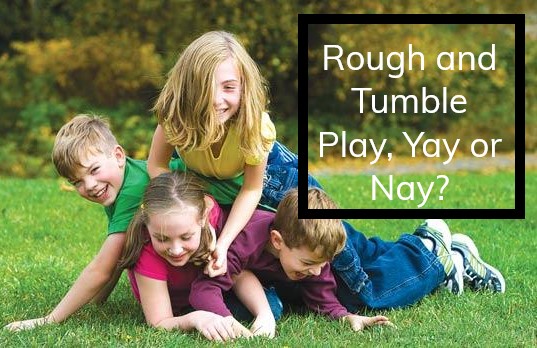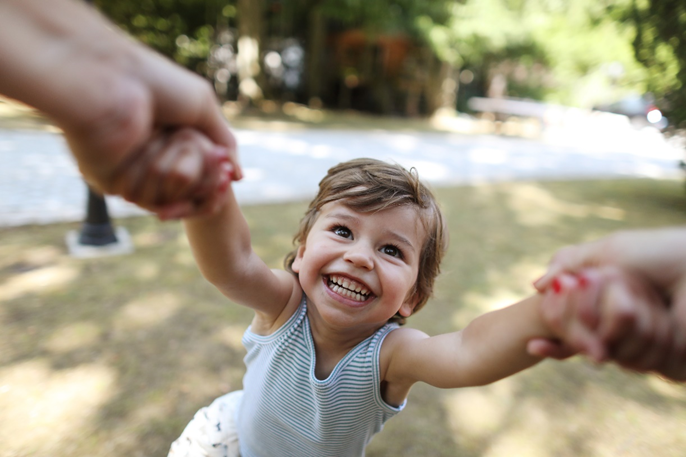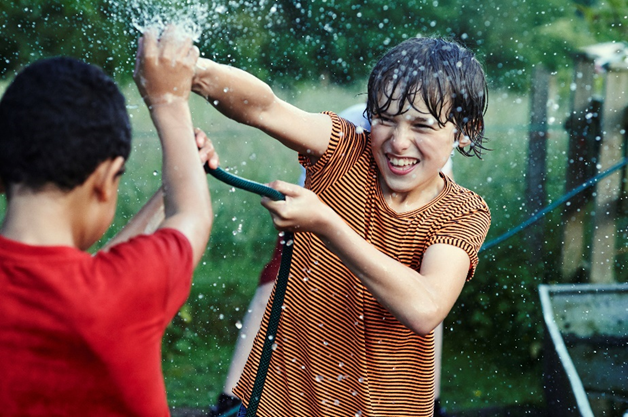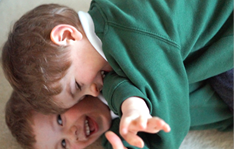Our child care programs, summer camp, and forest school are child-centered and inquiry based.

By Marjorie LePoidevin, Director Communications and Marketing
Parents and caregivers of younger children may feel like they are constantly reminding them to be “hands off” with their playmates or to “settle down”. You may feel differently, after reviewing what research has discovered about this type of play.
We might think discouraging rough-and-tumble play such as wrestling, play fighting, and chasing is helping children to stay safe and fit in with current social expectations, but we need to examine this type of play more closely and understand its role in childhood development.
Research
A recent article in Science Daily cited a 2020 study undertaken by the University of Cambridge in cooperation with the Lego Foundation.
It concluded that children respond very positively to roughhousing and more physical play which teaches them about self-control not to mention providing other important benefits.
The Cambridge review examined many studies from 1977 to 2017 looking specifically at the role of father-child play, its frequency, what type of play was enjoyed, and any long-term benefits.
What they found was that fathers tend to have a more rowdy and active style of play and that this play was typically engaged in daily, which correlated to less hyperactivity, and less emotional and behavioral problems in the children which included reduced aggression and increased self-control in settling disagreements at school.
How can this be?
Paul Ramchandani, Professor of Play in Education, Development and Learning at the University of Cambridge, said:
“Physical play creates fun, exciting situations in which children have to apply self-regulation.” You might have to control your strength, learn when things have gone too far — or maybe your father steps on your toe by accident and you feel cross!”
“It’s a safe environment in which children can practice how to respond. If they react the wrong way, they might get told off, but it’s not the end of the world — and next time they might remember to behave differently.”
While this study was specifically looking at father-child play, it is important to note that these concepts can benefit all families. Physical play doesn’t rest solely in the realm of parents either, children derive the same benefits when engaging in rough and tumble play with one another.

The study does, however, remind all parents and caregivers that children need access to varied types of play including physical, boisterous, and adventurous play. Grown-ups may need to practice getting out of their comfort-zone and embrace more physical play with children or provide opportunities for this play elsewhere such as sports, or regular play dates with peers.

Childcare Environment
We have the same concerns about rougher play in our childcare centres. Take a recent experience at our after-school program at Little Rouge PS for example.
Supervisor Cheryl McCurrie explained that the educators noticed that several children in the program were regularly engaging in ‘play-fighting’ activities and occasionally it went too far, and the children were sometimes getting hurt.
Cheryl encouraged her team to meet with the express goal of brainstorming ideas around incorporating the children’s interest in fighting into the program. Rather than focus on eliminating the play, or separating the children, the educators embraced this as an opportunity to redirect their energy in a positive way while respecting the interests and developmental needs of the children.
As part of their plan, the educators asked if the children were ‘super-heroes’, which was enthusiastically embraced by the children. The idea took off from there and sparked costume planning, appropriate super-hero poses, creating comic strips, and finally a super-hero movie. The experience then expanded to script planning, choreography, sets, and so much more.
It is important that their initial roughhousing was used as the basis of choreographed moves and scenes in the movie, incorporating the rougher play the children wanted, but in a way that wasn’t hurting each other.
Defining Rough Play
Frances M. Carlson, author of Big Body Play, and a teacher of early childhood educators in Georgia, also reminds us of what such play is and isn’t.
“When two children are fighting, one runs away as soon as possible and does not voluntarily return for more. While enjoying rough play, children have free and easy faces. Their muscle tone is relaxed, and they are usually smiling and laughing. In real fighting, one child is typically dominating another child who may be in that situation against their will.” Carlson also notes that participants “in rough play will take turns and extend such play, returning for more, even when it looks too rough to adults.”
Benefits of Roughhousing
Carlson reminds us that such physical play has many benefits related to all learning domains for children: physical, social, psychological, cognitive, and language.
Physical Domain
- Intense physical exertion, exercising the whole body and expending large amounts of energy.
- Access to physical contact. Children often hug or pat each other on the back during and after such play. Wrestling typically involves tight hugs.
- Complex motor learning and co-ordination which involves understanding the limits of their strength and exploring their changing positions in space (proprioceptive development). This area of development is critical, and many health experts are seeing significant delays due to the sedentary lifestyles of children today.
Social Domain
- Turn-taking, reciprocity, alternating and changing roles.
- The ability to ‘read’ physical cues such as gestures, body language, leads to stronger friendships.
- Justice mediation and peace keeping skills.
Psychological Domain
- Intense physical exercise increases a child’s ability to achieve calm, improving self-regulation and executive function.
Cognitive and Language
- Children are not natural ‘turn-takers’ and therefore must discuss the ‘rules of engagement’ for their play and must often negotiate as things progress.
It makes sense that this type of play starts when a child is young, seems to intensify around ages 4 to 8, and gradually dissipates as the child gets involved in organized sports or activities which satisfy these learning needs at a developmentally appropriate level.
Risk
Such play is obviously not without risk and environments such as childcare programs have responsibility for supervision and mitigation of risk. That doesn’t mean however, that risk is eliminated. One of the most important aspects of this type of play is that there remains an element of risk which actively supports
the children’s learning around boundaries, social cues, and physical limits. By implementing some structure around risky play, educators can increase the comfort level for parents and safety of the children.
Supervision Strategies
- a definition of rough play; what it is and isn’t
- developmentally appropriate rules for engaging in rough play; understanding limits and consent; using specific examples (setting boundaries such as no kicking, open hands only, stop as soon as someone signals or asks etc.)
- helping children problem solve: “how can you play so that one person isn’t pinned under the other one?”
- setting expectations for how educators will provide supervision
- strategies for including all children
Finally, while not all children engage in roughhousing, for those that do, their behaviour shouldn’t be cause for concern for parents or caregivers. Rougher play can fulfill many developmental needs of children and working with the children to navigate how to appropriately play physically with each other can result in many benefits.
References:
- Science Daily, “Playtime with dad may improve children’s self-control.” June 29, 2020.
- Annabel Amodia-Bidakowska, Ciara Laverty, Paul G. Ramchandani. Father-child play: A systematic review of its frequency, characteristics and potential impact on children’s development. Developmental Review, 2020; 57: 100924 DOI: 10.1016/j.dr.2020.100924
- Frances M. Carlson. Rough in a Good Way – Supporting Children’s Big Body Play. Child Care Bridges, Fall 2012, V 3: Manitoba Child Care Association

